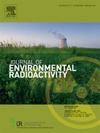Effects on the middle adult stage of the Tohoku hynobiid salamander, Hynobius lichenatus, chronically γ-irradiated from the embryonic stage
IF 2.1
3区 环境科学与生态学
Q3 ENVIRONMENTAL SCIENCES
引用次数: 0
Abstract
Tohoku hynobiid salamanders, Hynobius lichenatus (Amphibia, Caudata), were chronically irradiated with 137Cs γ-rays from the embryonic to the middle adult stages for over 3000 days, and the effects on survival, somatic growth (body weight increase), sexual maturation, and histological characteristics were examined. This article reports the effects observed in the middle adult stage (days 1955–3039). Irradiation at a dose rate of 34 μGy h−1 had no effect on any endpoint. At 150 or 500 μGy h−1, secondary sexual characteristics (tubercle at the anterior angle of the cloacal vent for males and ovisac development for females) were not observed. Gonads were either severely atrophied or unidentified by histological examination. At some peripheral liver sites, the number of haematopoietic cells was significantly reduced. Renal damage was also observed. At 500 μGy h−1, somatic growth was significantly inhibited, and 74 % of individuals died due to multiorgan failure. No tumours were observed in the dead salamanders. A dose rate-response relationship obtained in this study suggests that the derived consideration reference level of the International Commission on Radiological Protection for the Reference Frog (i.e., 40–400 μGy h−1) is applicable for the protection of H. lichenatus, and that this salamander may not have been adversely affected even in the most severely contaminated area in Fukushima, where the highest dose rate to salamanders was estimated to be 47 μGy h−1 in April 2012.
从胚胎期开始慢性γ-辐照对东北小鲵成虫中期的影响
用137Cs γ射线对东北水螅(Hynobius lichenatus, Amphibia, Caudata)从胚胎期到成虫中期持续照射3000 d,观察了对其存活、体生长(体重增加)、性成熟和组织学特征的影响。本文报道了在成人中期(1955-3039天)观察到的效果。34 μGy h−1的剂量率对任何终点均无影响。在150或500 μGy h−1时,没有观察到第二性征(雄性在泄殖腔口前角有结节,雌性没有观察到卵巢发育)。性腺严重萎缩或组织学检查未发现。在一些外周肝脏部位,造血细胞数量明显减少。肾脏损害也被观察到。500 μGy h−1时,体细胞生长明显受到抑制,74%的个体因多器官衰竭而死亡。在死亡的蝾螈中没有观察到肿瘤。本研究得出的剂量率-反应关系表明,国际放射防护委员会对参考蛙的衍生考虑参考水平(即40-400 μGy h−1)适用于对lichenatus的保护,即使在福岛污染最严重的地区,这种蝾螈也可能没有受到不利影响,在2012年4月,该地区对蝾螈的最高剂量率估计为47 μGy h−1。
本文章由计算机程序翻译,如有差异,请以英文原文为准。
求助全文
约1分钟内获得全文
求助全文
来源期刊

Journal of environmental radioactivity
环境科学-环境科学
CiteScore
4.70
自引率
13.00%
发文量
209
审稿时长
73 days
期刊介绍:
The Journal of Environmental Radioactivity provides a coherent international forum for publication of original research or review papers on any aspect of the occurrence of radioactivity in natural systems.
Relevant subject areas range from applications of environmental radionuclides as mechanistic or timescale tracers of natural processes to assessments of the radioecological or radiological effects of ambient radioactivity. Papers deal with naturally occurring nuclides or with those created and released by man through nuclear weapons manufacture and testing, energy production, fuel-cycle technology, etc. Reports on radioactivity in the oceans, sediments, rivers, lakes, groundwaters, soils, atmosphere and all divisions of the biosphere are welcomed, but these should not simply be of a monitoring nature unless the data are particularly innovative.
 求助内容:
求助内容: 应助结果提醒方式:
应助结果提醒方式:


